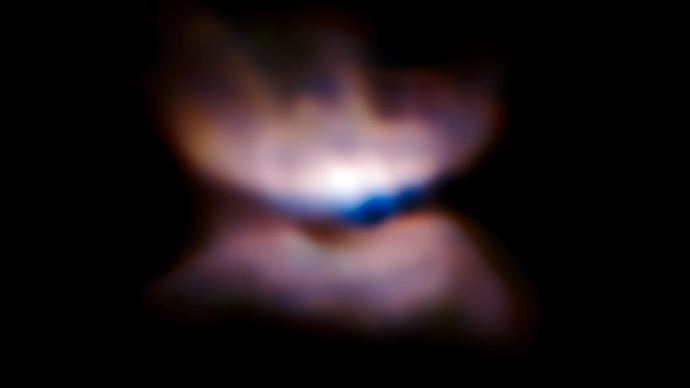Astronomers net celestial ‘butterfly’ born from dusty cocoon (PHOTOS)

The Very Large Telescope (VLT) has for the first time ever caught a glimpse of a cosmic miracle of birth, a butterfly-like planetary nebula. It recently appeared from dust surrounding a slowly dying star and its younger companion.
These are some of the sharpest images ever snapped with the European Southern Observatory’s (ESO's) Very Large Telescope. The shots are said to be three times sharper than those from the NASA/ESA Hubble Space Telescope.

A report on the observations was published in the Astronomy & Astrophysics journal on Wednesday.
The VLT’s observations, with the newly installed SPHERE instrument, revealed L2 Puppis, a red giant in its final stages of life. About 200 light-years away, it’s one of the closest red giants to Earth.
The observations have also shown the star has a close stellar companion, 300 million kilometers away, which is twice the distance from Earth to the Sun. It is also believed to be a red giant, but with lower mass and less evolved.
However, what fascinates scientists most is the dust around L2 Puppis. Arranged in a disc, it is 900 million kilometers from the star and surrounds it like a symmetrical funnel, a planetary nebula that looks like a butterfly.

The three conditions – a dying star, its companion and a vast dust cloud – are believed to contribute to the formation of such bipolar planetary nebula.
“With the companion star orbiting L2 Puppis only every few years, we expect to see how the companion star shapes the red giant’s disc. It will be possible to follow the evolution of the dust features around the star in real time — an extremely rare and exciting prospect,” lead author of the paper, Pierre Kervella, said.
READ MORE: Space Odyssey 2015: SpaceX Falcon 9 rocket captures Earth on GoPro (VIDEO)
While there is still a lot to be studied, the new images may help scientists to gain a better understanding of the bipolar planetary nebulae. The two leading theories rely on the existence of a binary star system.
“The origin of bipolar planetary nebulae is one of the great classic problems of modern astrophysics, especially the question of how, exactly, stars return their valuable payload of metals back into space — an important process, because it is this material that will be used to produce later generations of planetary systems,” lead author of the paper, Pierre Kervella, said in the press release
The images of L2 Puppis are the first published results using the new SPHERE instrument and the most detailed for such a star.
ESO is Europe’s leading astronomy organization, uniting 16 countries. Its observation sites are in Chile, with the Very Large Telescope operating in Paranal.












